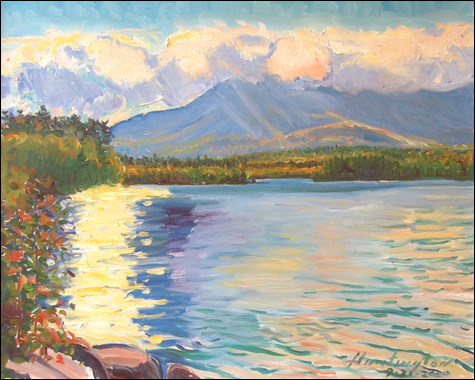
"KATAHDIN AFTERNOON, KATAHDIN LAKE": Oil on canvas, 23.5 x 29.5 inches, by Chris
Huntington.
|
|
“Katahdin: The Lake And Her Artists” through March 15 | at Jameson Gallery, 305 Commercial St, Portland | 207.772.5522
|
Over the last couple of years there has been a major, and successful, effort to find funds to acquire a 4000-acre parcel of land that includes Katahdin Lake and to make it part of Baxter State Park. A group of artists were deeply involved in this project, and there are now two big group shows by many of these artists to commemorate the event, one at Bates College and the other, “Katahdin: The Lake and Her Artists,” at Jameson in Portland.
It’s worth considering the relationship between the history of landscape painting and the growth of the idea that the natural world is something to be valued and preserved. Landscape painting is fairly new in the history of art, having become common in the late 18th and early 19th centuries. It is arguable that painters going off into the wilderness and coming back with images for homes and museums sparked changes in attitudes about trees, mountains, and lakes. Nature started to be valued for itself, rather than as a supply of resources to be struggled for and extracted.
Many, if not most, of the artists in this show reprise the actions of the older painters and take directly to the woods. Chris Huntington, David Little, and Marsha Donahue, to name a few who will be familiar to Portland, pack up their easels and brushes and brave the bugs to work on the spot. It’s not a method for the faint of heart.
Mount Katahdin, the lake, and its environs are the subject of most of the works in the show; group shows with a single, similar subject are pretty rare these days.
Taken together, the successful political action and conservation campaign, the similar methods, the same subject, and the historical resonance, still don’t add up to a coherent reason for a big group show. For a great party, for sure, and this show needs to be seen in that spirit. With all the things the artists have in common, there are still deep differences among them in the nature of what they are about. The viewer gets to pick and choose among the fifty-odd works by 18 artists according to preference, taste, or whim.
For example, Chris Polson in “Last Color, Katahdin Lake” lays colors in discrete areas that border each other, rather than modulating from one to another. It’s an approach informed by later modernist painters. Chris Huntington in “Katahdin Afternoon, Katahdin Lake” uses the scene and colors as starting point for a record of his inner experience. Early modern, perhaps, and definitely personal and intense.
David Little’s work relates more to Impressionism. “Katahdin” has a loose, easy hand, but the overall sense of the work is that of a record of how the light and colors actually looked, shorn of details but with a real sense of the moment. Michael Vermette’s work has a more narrative quality than most of the others. The hiker in “Into the Woods, Turner Mountain” is shown in the act of stepping over a fallen tree. It’s a moment in a story. In “Rocky Pond Afternoon” Bruce McDonald simplifies, rendering the mountain and lake without a lot of detail, concentrating on the broader relationship of lake, land, and sky.
At big shows like this it’s fun to pick a personal favorite, and here’s mine for that day. It’s a work on paper by Marsha Donahue that uses a technique that I haven’t seen for more years than I care to count. “Katahdin from Wilderness Camps” uses black and white charcoal, with the black holding the shadows, the white creating the highlights, and the mid-range tones supplied by the brown paper it’s drawn on. It’s a modest work with gusto and charm.
Ken Greenleaf can be reached at
ken.greenleaf@gmail.com
.